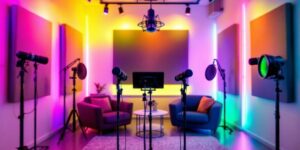Video podcasting has become a game-changer for content creators, influencers, entrepreneurs, and businesses looking to make a lasting impact in the digital world. Unlike traditional audio-only podcasts, video podcasts offer an immersive experience by combining storytelling with visuals—perfect for platforms like YouTube, TikTok, and Instagram.
As podcast discoverability increasingly relies on visuals and shareability, understanding how to make a video podcast that captivates viewers and performs across social media is no longer optional—it’s essential. In this guide, we’ll explore proven video podcasting tips, strategic setups, and ways to optimize content to reach a wider audience and boost engagement.
Why Video Podcasting Is the Future of Content
Podcasting has evolved. While audio remains the core of many shows, video podcasting provides a more dynamic and engaging way to build deeper connections with your audience. On platforms like YouTube, users expect both quality and authenticity. They don’t just want to hear your thoughts—they want to see your expressions, your body language, and the vibe of your space.
Whether you’re offering interviews, solo insights, or roundtable discussions, video content adds a layer of trust and relatability that can’t be achieved through audio alone. This is why more podcasters are shifting toward full visual production.
Choosing the Best Video Podcast Format for Your Show
Before you record anything, it’s important to decide on the format that best suits your goals, audience, and resources. Are you planning to host a solo show, conduct guest interviews, run a panel discussion, or co-host with a partner?
Each of these formats comes with its own energy, challenges, and equipment requirements. Solo shows are easier to manage but require strong content flow. Interviews demand a solid guest lineup and chemistry. Roundtable formats are rich in perspectives but require more complex video podcast setups.
No matter the style, the most important element is consistency. Audiences return to content that’s predictable in structure, pacing, and delivery.
Building a Professional Video Podcast Setup
A compelling video podcast starts with a high-quality production environment. Your podcast setup should align with your brand’s identity while ensuring optimal audio-visual clarity.
Your environment should be quiet, well-lit, and visually appealing. Avoid busy backgrounds or cluttered spaces. The goal is to create a clean frame that keeps your audience focused on you and your message. Branding your background with logos or thematic visuals also helps establish a recognizable look.
In terms of audio, invest in a reliable microphone and soundproofing elements. Poor audio can instantly turn viewers away—even if your video quality is exceptional. Studios like Podcast Studio AZ offer professionally treated spaces with all equipment pre-installed, so you can focus purely on your content
How to Record a Video Podcast Like a Pro
Recording a video podcast involves preparation, technical precision, and on-camera confidence. Start with a structured outline or script to stay on track. Decide whether you’ll record in one take or break it into segments. Keep energy levels high, use natural body language, and maintain eye contact with the camera to simulate one-on-one engagement with your audience.
If you’re recording remotely, make sure your internet connection is stable, your webcam is high resolution, and you’re using recording software that offers split-screen and backup audio options.
Post-recording, it’s important to watch your footage with a critical eye. Look for awkward transitions, unclear points, or technical flaws you can correct in editing. The goal is to deliver a clean, polished video that feels effortless to viewers.
Podcast Camera Setup That Boosts Visual Engagement
Your camera placement can significantly influence viewer perception and engagement. The ideal setup places your camera at eye level, with a head-and-shoulders frame. This framing mimics a natural face-to-face conversation and makes the viewer feel more connected.
Consider using a DSLR or mirrorless camera if budget allows. These provide superior depth of field, autofocus, and color grading flexibility compared to standard webcams. Good lighting, such as softbox or LED ring lights, can make even a basic setup look professional.
To further enhance visual impact, experiment with multiple camera angles or add motion graphics during editing. These small tweaks can dramatically increase the watch time and shareability of your episodes.
Creating Engaging Video Podcast Ideas That Keep Viewers Hooked
Choosing the right topics is just as important as how you present them. The most engaging video podcast ideas are those that provide value, spark conversation, or deliver emotional impact. Think about your audience’s challenges, curiosities, and passions.
You might explore behind-the-scenes stories, expert interviews, controversial takes on trending news, or listener-submitted Q&A segments. Storytelling should be at the core of each episode. Visual storytelling—through body language, props, or slide overlays—can add another layer of connection.
Use emotional triggers like humor, suspense, or inspiration to keep your viewers invested. And remember, the first 10 seconds of your video are critical—use them to hook your audience with a bold statement or question.
Video Podcasting for YouTube: What Works and What Doesn’t
YouTube is the king of long-form video and the perfect home for video podcasts. But to thrive on YouTube, you must understand its unique ecosystem. The platform prioritizes watch time, viewer retention, and engagement. That means your content needs to be both entertaining and optimized.
Use descriptive titles with relevant keywords like “how to make a video podcast” or “best podcast setup for beginners.” Design high-quality thumbnails that create curiosity without clickbait. Break long episodes into chapters using timestamps, and encourage likes, comments, and subscriptions to drive algorithmic visibility.
Don’t forget about the YouTube podcast algorithm. The more your videos are watched from beginning to end, the more likely they are to be recommended to new viewers. Keep your intros brief, eliminate filler content, and use overlays or visuals to maintain attention.
Promoting Your Podcast on YouTube and Social Media
A great podcast won’t get far without smart distribution. Promoting your podcast on YouTube is just one part of the puzzle. You also need a strong social media podcast strategy to extend reach, build community, and grow your audience across multiple platforms.
On Instagram and TikTok, repurpose your video podcast into short, vertical clips with captions. On Facebook, share full-length episodes and create discussion threads. On LinkedIn, pull out key insights or takeaways as quote cards or mini-blogs. On Twitter/X, post soundbites and teaser clips with compelling hooks.
Be sure to tailor your content to each platform. A 30-second reel that works on TikTok won’t necessarily perform the same on LinkedIn. Use hashtags, tag guests, and post consistently to build momentum and visibility.
Podcast Video Content Ideas That Inspire Shares
Looking for content that spreads naturally? Focus on creating moments that make viewers want to share your video. This might be an emotional story, a surprising fact, or a bold opinion. Clip these moments and post them as standalone social media assets.
Episodes with guests also perform well when guests share the content with their own followers. Prepare guests with promotional materials, such as audiograms, video snippets, and graphics they can repost.
Behind-the-scenes content, bloopers, or bonus segments are also highly shareable. Audiences love seeing the “real” you—it builds trust and encourages word-of-mouth promotion.
Optimizing Video Podcasts for Engagement and Retention
Engagement is the heartbeat of any successful podcast. Whether it’s likes, comments, shares, or subscriptions, every interaction fuels algorithmic growth. That’s why optimizing your episodes for retention and viewer involvement is crucial.
Begin with a strong, hook-driven intro. Use on-screen prompts to encourage comments or questions. Ask viewers to subscribe or share if they enjoyed the episode. Break your content into digestible segments, and use visual transitions to signal topic changes.
Finally, end your video with a clear call-to-action. Direct viewers to your website, invite them to listen to the audio version, or tease the next episode to keep them coming back.
Conclusion: Let Your Voice Be Seen
Creating a successful video podcast is more than just adding a camera to your mic—it’s about telling stories that matter, sharing your message with confidence, and designing a visual experience that captivates viewers from start to finish.
With the right setup, creative planning, and social media strategy, your video podcast can become a powerful tool for building community, authority, and brand loyalty.
If you’re ready to take your podcast to the next level with professional equipment, expert guidance, and a studio designed for both visual and audio success, look no further than Podcast Studio AZ. Our team is here to help you launch, record, and distribute content that performs on every platform.
Book your studio session with Podcast Studio AZ today—and let your voice be seen.




